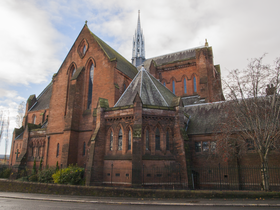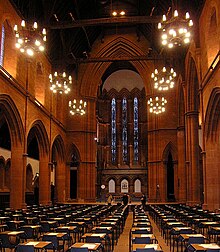Barony Hall
| Barony Hall | |
|---|---|
 | |
 | |
| Former names | Barony Church |
| General information | |
| Status | Completed |
| Type | Academic |
| Location | Glasgow, Scotland |
| Address | Glasgow G1 1XQ |
| Coordinates | 55°51′43″N 4°14′13″W / 55.8619°N 4.2370°W |
| Current tenants | University of Strathclyde |
Barony Hall, also known as Barony Church, is a red sandstone Victorian Gothic church located on Castle Street in Glasgow, Scotland, near the Glasgow Cathedral and the Glasgow Royal Infirmary. Together with the Glasgow Cathedral and oldest surviving house, Provand's Lordship, which are both near Glasgow's historical High Street, Barony Hall establishes its place as a city's heritage and a fine example of Gothic architecture. The Old Barony Church was built as a part of the Barony Parish in Glasgow by architect, James Adams. It opened in 1799 and served ceremonial and other congregational purposes. The replacement for the old building was designed by J.J. Burnet & J.A. Campbell and raised in 1889, and incorporated architectural artifacts from the old church and a number of other relics.[1][2]
The New Barony Church was acquired by the University of Strathclyde in 1986. It was restored to its former glory by 1989 and is now utilized as a ceremonial hall, as well as serving other university purposes, known as the Barony Hall.[3]
History

The Barony Church has existed for approximately 400 years, dating from before 1595 until 1985. Over that time it became one of the top parishes of the Church of Scotland. Among the notable ministers who have resided in the Barony Parish are Zachary Boyd (1625–1653), Norman McLeod (1851–1872) and John White (1911-1934). Barony Parish received its name from the Barony of Glasgow.
The early Barony Church, which was established in a crypt was mentioned in Sir Walter Scott's Rob Roy. In the book, which was set in the early 18th century, the church was described as :"an extensive range of low-browed, dark, and twilight vaults, such as are used for sepulchres in other countries, and had long been dedicated to the same purpose in this, a portion of which was seated with pews and used as a church. The part of the vaults thus occupied, though capable of containing a congregation of many hundreds, bore a small proportion to the darker and more extensive caverns which yawned around what may be termed the inhabited space."
The conditions of the early church gradually worsened over time, until it was decided to be rebuilt in 1798 with the architect James Adam. The new design was met with praise, as well as criticism. Some considered it an architectural jewel, whilst others despised its looks and considered it borderline unappealing, even repulsive. One of the Church's own ministers, Dr. Norman McLeod, is reported to have advised Queen Victoria that it was "the ugliest Kirk in all Europe". With the opening of this new church, the old crypt was used as a burial ground until 1844.

However, not even the new building could solve some of the Barony Church's problems. The few roads leading to the church were little more than dirt tracks, making traveling to and from the church immensely difficult for many of the congregation, especially during winter. It also could not sustainably fulfill all the spiritual requirements of the congregation. This led to several Chapels of Ease being built throughout the Barony area, usually by the local people to provide, at the very least a provisionary solution to the problems of the Barony Kirk.
Eventually, a replacement of the church was needed, in order to provide a solution to the problems. A site was acquired on the west side of Castle Street and a magnificent, red sandstone Gothic church, inspired by Girona Cathedral and Dunblane Cathedral,[4] designed by J.J. Burnet & J.A. Campbell as a part of a competition, was finished in 1889. This new building incorporated architectural artifacts from the old church and a number of other relics. The new building was dedicated in a service on 27 April 1989. An article in the following day's Glasgow Herald made no direct comment on the building but focused on the sermon by John Caird, the Church of Scotland minister and Principal of the University of Glasgow, in which he "dealt with art in relation to worship, stating that it was weak and foolish to identify purity of worship with ruggedness and baseness of form".[4]
This new building provided a superb home for the congregation, which was eventually joined by that of St. Paul's & St. David's (Ramshorn) to form the Barony Ramshorn in 1982. However, the congregation did not last long. It was around this time that the Barony broke off into four different parishes: Shettleston (1847), Calton (1849), Maryhill (1850) and Springburn (1854). Church attendees decided to return to St. George's Tron, others to Dennistoun Blackfriars and many came back to the place where Barony originated from, Glasgow Cathedral. Some of the relics from the Barony Church were taken back to the cathedral, including the Communion Table, and a chapel was established in the cathedral's crypt.
The church was in use for over 100 years and the last service was held on 6 October 1985. All the Castle Street buildings were acquired by Strathclyde University a year later, in 1986. The church was restored once again in 1989 by the University and is now used as a ceremonial hall known as Barony Hall.[1] The development, designed by David Leslie Architects, cost £3.4 million, with sums received through grants and hundreds of private donations.[5]
Barony Hall today

The war is also marked by a memorial to the dead – a plaque bearing 125 names connected to the church at the side of the stage in the Great Hall. Below sits a solitary reminder of the unlamented 1799 building, its foundation stone, bearing the names of the ministers who served there during its 90-year life.[4]
An original inscription can be found on a pillar of Barony Church on the corner of the Rottenrow street and Castle street, dedicating the building to the glory and worship of God. The date stated on the pillar dates back to the first dedication service held in the rebuilt building, on 27 April 1989. A new inscription can be found under the original one, which was added after the acquirement of the Church by the University of Strathclyde, addressing the building as Barony Hall and as a part of the university campus.
As befits such a momentous venue, the Barony houses one of Scotland's grandest organs, the Maurice Taylor Organ, which was installed in 2010. A Bach-style organ, the first of its kind to be commissioned in the UK, the instrument is designed for performances of Bach's music in their original form and has been used for numerous concerts and recitals since it took its place.[4] The organ has forty-one speaking stops, three manuals, one pedal, three thousand pipes, and features mechanical key and stop action. The bellows feeding air can be blown by foot, authentic to the Baroque period, as well as electrically.[6]
The restoration work following Strathclyde's acquisition of the Barony earned high acclaim in architectural and design circles, winning many awards from Europa Nostra Award, the UK Civic Trust, Glasgow Civic Trust and the Royal Incorporation of Architects in Scotland. The certificates for these awards are displayed in the corridor which connects the Great Hall to the cloakroom. These are displayed along with the thousands of degree certificates which have been distributed in the Barony over the past quarter of a century, serving as a testament to the building's significance for Strathclyde – a place where tradition is continued and achievement recognized.[4]
Functions

After the Barony Church building was acquired by the University of Strathclyde in 1986, it came into use as the University's Barony Hall, hosting graduations, major exams, examinations, and functions.[7] Aside from university purposes, the Barony Hall is one of the most renowned venues in the Glasgow city center. The hall hosts a variety of celebrations and formalities such as:
- Weddings - The Great Hall and the Winter Gardens provide the perfect atmosphere and ideal setting for weddings. Located in the city center, it is easily reachable by public transport such as Buchanan bus station and Glasgow Queen Street railway station.[8]
- Graduation - The Barony Hall hosts every year's inauguration events and graduation ceremonies for the students of the University of Strathclyde.
- Exhibitions
- Meetings
- Seminars
- Concerts
- Functions
There are three more areas in the building - the Winter Gardens, the Bicentenary Hall, and the Sir Patrick Thomas Room. These can be used for many purposes such as registration, catering, and break-out areas. Main events taking place in the Barony Hall are exhibitions, weddings, dinners, dinners/dances and receptions. The Hall offers more than 250 square metres of space and can hold up to 500 people (theatre-style) on the flat floor area in the Great Hall or up to 600 when using the Balcony.[9]
Notable connections
John Marshall Lang, father of Cosmo Gordon Lang, Archbishop of Canterbury from 1928 until 1942, was a minister at the Barony Church.[10]
References
- ^ a b "Barony Church - East End Glasgow History". www.glasgowhistory.co.uk. Retrieved 11 November 2016.
- ^ Hollis, Peter (2007). The Barony of Glasgow, a window onto church and people in nineteenth century Scotland. Dunedin Academic Press. ISBN 190376579X.
- ^ GENUKI. "Genuki: Barony, Lanarkshire". www.genuki.org.uk. Retrieved 11 November 2016.
- ^ a b c d e "Archives & Special Collections, Strathclyde- Week 42 - Plans of the Barony Church by Burnet,..." Archives & Special Collections, Strathclyde. Retrieved 2 December 2016.
- ^ The Scottish Civic Trust (2 December 2016). "New Uses for Former Church Buildings" (PDF). The Scottish Civic Trust. Retrieved 2 December 2016.
- ^ Charlston, Terence (Spring 2011). "The Barony Hall Organ and its wider context" (PDF). Retrieved 2 December 2016.
- ^ "Barony Church, Glasgow - University of Strathclyde Archives". strathclyde.ica-atom.org. Retrieved 11 November 2016.
- ^ WeddingVenues.com. "The Barony - The University of Strathclyde – wedding venue near Glasgow, Strathclyde | WeddingVenues.com". www.weddingvenues.com. Retrieved 15 November 2016.
- ^ "Barony Hall - University of Strathclyde". www.strath.ac.uk. Retrieved 11 November 2016.
- ^ Oxford University Press. pp. Wilkinson, Alan. "(William) Cosmo Gordon Lang (1864–1945)". Oxford Dictionary of National Biography (online ed.). Oxford University Press. doi:10.1093/ref:odnb/34398. (Subscription or UK public library membership required.) ("Early Life" section).
